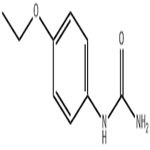Dulcin is a non-nutritive sweetener. Dulcin is a sweet analgesic for use in medical procedures or treatments.
ChEBI: Dulcin is a member of ureas.
4-Ethoxyphenylurea, dulcin, is produced from the addition of potassium cyanate to p-phenetidine hydrochloride in aqueous solution at room temperature or from mixing urea and p-phenetidine hydrochloride to a mixture of hydrochloric acid and glacial acetic acid.
Partially decomposes on heating in water; hydrolyzes in 0.1 N acetic acid. Slightly water soluble .
DULCIN is an example of an amide. Amides react with azo and diazo compounds to generate toxic gases. Flammable gases are formed by the reaction of organic amides with strong reducing agents. Amides are very weak bases (weaker than water). Imides are less basic yet and in fact react with strong bases to form salts. That is, they can react as acids. Mixing amides with dehydrating agents such as P2O5 or SOCl2 generates the corresponding nitrile. The combustion of these compounds generates mixed oxides of nitrogen (NOx).
Human poison by
ingestion. Moderately toxic experimentally
by ingestion. Human systemic effects by
ingestion: somnolence, hallucinations,
distorted perceptions, and changes in motor
activity. In adults 20 to 40 g produces
dizziness, nausea, methemoglobinemia,
cyanosis, and hypotension. Questionable
carcinogen with experimental tumorigenic
data. When heated to decomposition it
emits toxic fumes of NOx.

